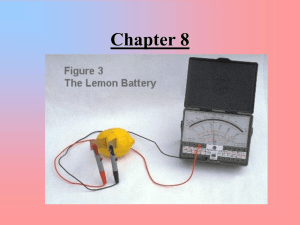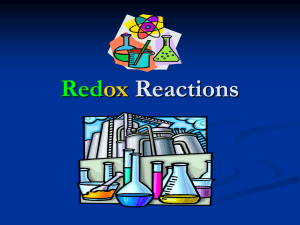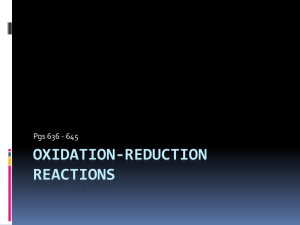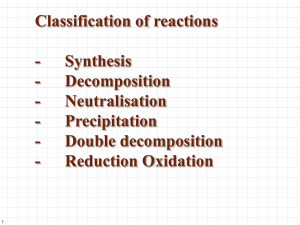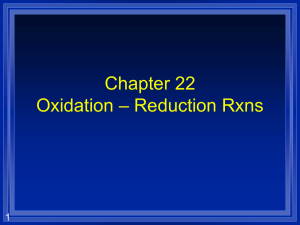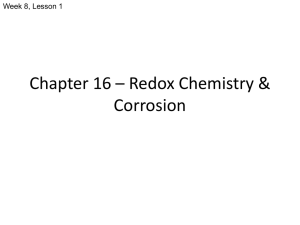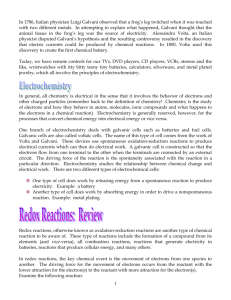oxidation - reduction reaction
advertisement
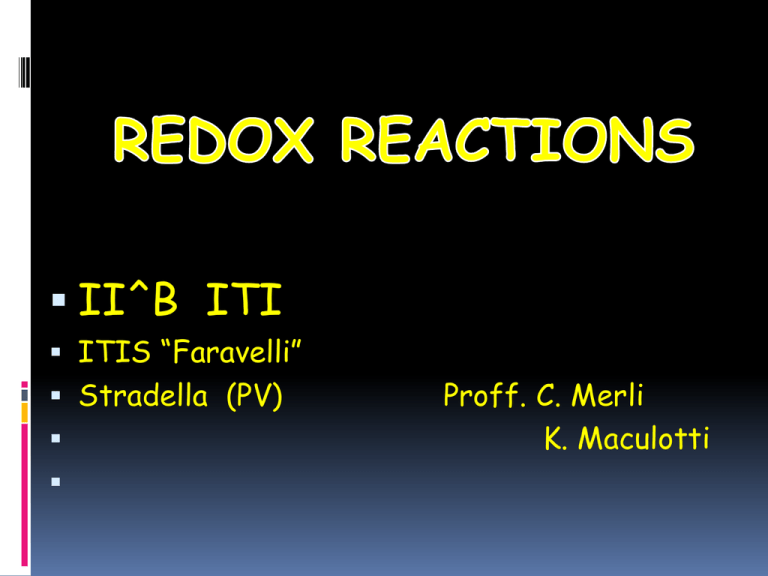
II^B ITI ITIS “Faravelli” Stradella (PV) Proff. C. Merli K. Maculotti Words to Know Combustion: An oxidation-reduction reaction that occurs so rapidly that noticeable heat and light are produced. Corrosion: An oxidation-reduction reaction in which a metal is oxidized and oxygen is reduced, usually in the presence of moisture. Oxidation: A process in which a chemical substance takes on oxygen or loses electrons. Oxidizing agent: A chemical substance that gives up oxygen or takes on electrons from another substance. Reducing agent: A chemical substance that takes on oxygen or gives up electrons to another substance. Reduction: A process in which a chemical substance gives off oxygen or takes on electrons. Types of redox reactions. Redox reactions are among the most common and most important chemical reactions in everyday life. The great majority of those reactions can be classified on the basis of how rapidly they occur. Combustion. Combustion means burning. Any time a material burns, an oxidation-reduction reaction occurs. The two equations below show what happens when coal (which is nearly pure carbon) and gasoline (C 8 H 18 ) burn. You can see that the fuel is oxidized in each case: C + O 2 → CO 2 2 C 8 H 18 + 25 O 2 → 16 CO 2 + 18 H 2 O In reactions such as these, oxidation occurs very rapidly and energy is released. That energy is put to use to heat homes and buildings; to drive automobiles, trucks, ships, airplanes, and trains; to operate industrial processes; and for numerous other purposes. Rust. Most metals react with oxygen to form compounds known as oxides. Rust is the name given to the oxide of iron and, sometimes, the oxides of other metals. The process by which rusting occurs is also known as corrosion. Corrosion is very much like combustion, except that it occurs much more slowly. The equation below shows perhaps the most common form of corrosion, the rusting of iron. 4 Fe + 3 O 2 → 2 Fe 2 O 3 . Biological processes. Many of the changes that take place within living organisms are also redox reactions. For example, the digestion of food is an oxidation process. Food molecules react with oxygen in the body to form carbon dioxide and water. Energy is also released in the process. The carbon dioxide and water are eliminated from the body as waste products, but the energy is used to make possible all the chemical reactions that keep an organism alive and help it to grow Decay. The compounds that make up living organisms, such as plants and animals, are very complex. They consist primarily of carbon, oxygen, and hydrogen. A simple way to represent such compounds is to use the letters x, y, and z to show that many atoms of carbon, hydrogen, and oxygen are present in the compounds. When a plant or animal dies, the organic compounds of which it is composed begin to react with oxygen. The reaction is similar to the combustion of gasoline shown above, but it occurs much more slowly. The process is known as decay, and it is another example of a common oxidation-reduction reaction. The equation below represents the decay (oxidation) of a compound that might be found in a dead plant: C x H y O z + O 2 → CO 2 + H 2 O REDOX REACTIONS In the reaction below, for example, sodium metal (Na) reacts with chlorine gas (Cl 2 ) in such a way that sodium atoms lose one electron each to chlorine atoms: 2 Na + Cl 2 → 2 NaCl Because sodium loses electrons in this reaction, it is said to be oxidized. Because chlorine gains electrons in the reaction, it is said to be reduced. Oxidation the loss of electrons Reduction the gaining of electrons The change in the oxidation state of a species lets you know if it has undergone oxidation or reduction. Oxidation can be defined as "an increase in oxidation number". In other words, if a species starts out at one oxidation state and ends up at a higher oxidation state it has undergone oxidation. Conversely, Reduction can be defined as "a decrease in oxidation number". LEO the Lion Says GER LEO Loss of Electrons is Oxidation GER Gain of Electrons is Reduction Oxidation is ALWAYS accompanied by reduction. Reactions in which oxidation and reduction are occurring are usually called Redox reactions. Example: Cu(s) + 2Ag+(aq) → Cu2+(aq) + 2Ag(s) We can now see a bit more clearly what changes are occurring with this reaction: 1. Copper began as a neutral atom with no charge, but changed into an ion with a charge of +2. An atom becomes a positive ion by losing electrons: Cu(s) → Cu2+(aq) + 2eNotice that copper began as a solid but is converted into aqueous ions - this is why the copper wire disintegrates. We say that copper was oxidized because is has lost electrons (electrons appear on the product side of the equation). 2. Silver was converted from an ion with a charge of +1, Ag+, to a neutral atom, Ag. The only way an ion can undergo this change is to gain an electron: Ag+(aq) + e- → Ag(s) Notice that solid silver is formed - this is what causes the fuzzy appearance to begin appearing on the wire - solid silver crystals. Silver has gained electrons - it has been reduced. (electrons appear on the reactant side of the equation.) The electrons that silver gained had to come from somewhere - they came from copper. Conversely, a substance such as copper can only lose electrons if there is something else that will take them up, the silver ions. One cannot occur without the other. This exchange of electrons is what defines an oxidation reduction reaction. How to balance the redox: Identify the elements that are oxidized and reduced by examining their Oxidation states Write the oxidation and reduction half-reactions and Balance Half Reaction Equations. In an acid solution, use H+ and H2O to balance the charges and other atoms. In a basic solution, use OH- and H2O to balance the charges and other atoms. Add the two half-reactions algebraically such that the electrons in the two half-reaction equations cancel completely. Cancel other species such as H+, OH-, and H2O common to the two sides, if necessary. Check your equation and make certain that numbers of atoms and charge are equal on both sides. ....some applications: the Daniell’s battery .............The end Thanks for your attention


